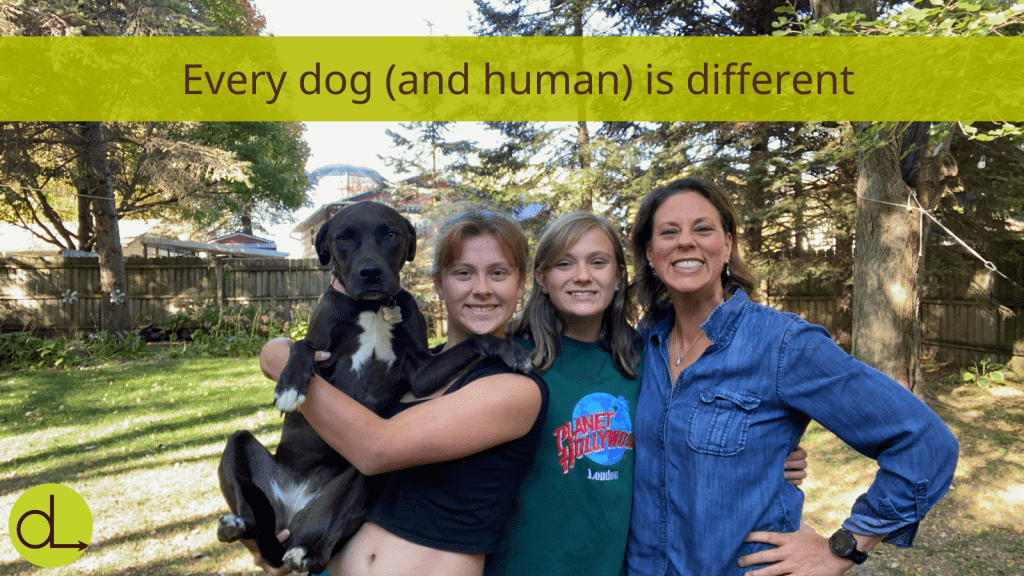Our family currently has foster dog #3. (And yes, we continue to refine our family dog alliance each time we get a new pup!) The paperwork said that Tiny was a 70-pound male who lived with six dogs. However, she turned out to be a 50-pound female who tolerates other dogs.
But she’s an absolute sweetheart! Mellow and calm, she’s completely content to sit outside by herself watching the squirrels for hours at a time. Our fostering experience with Tiny is completely different than with Sirius (who was the polar opposite of calm—we didn’t see squirrels in our backyard his entire stay with us) and Samson (who whimpered anytime we were more than three feet away from him).
What Dogs and Humans Have in Common
It’s been interesting to see how my daughters interact with each of the dogs. Sirius was our crash course in dog training. We had to learn a lot, very quickly, to keep our sanity—and the house in one piece. With Tiny, the tables turned. There’s no need for a gate. We don’t have to guard our meals or hide anything we don’t want to get chewed up. And when we go to bed, Tiny happily does too.
Simply put, Tiny, Sirius, and Samson are all very different dogs. And as a result, we’ve had to treat each of them differently in order to get them ready for their forever homes. We’ve learned that the first step to training a dog is to train the humans. A lot of times, your dog’s bad behavior is a direct reaction to your own behavior.
Bazooka! Can you say eye-opener?
It reminds me of managing people. Some employees require a lot of supervision. Others you can trust to do their own thing. Some need a lot of training to perform at the minimum standard for the position. Others come to your organization already exceeding your expectations.
As managers, we need to treat employees differently so they can reach their full potential. When I worked in Senator Kohl’s office, some on my team needed more direction and support than others to be successful. They were motivated in different ways and received feedback differently. As a result, I needed to change my management style to meet them where they were at (that took me years to learn—the hard way. You’re welcome!).
The Big Difference Between Dogs and Humans
When I share this with clients who lead a team, I often hear, “That sounds like it would take a lot of time and effort. It’d be easier if I could treat everyone the same—and if they just did what I told them to do!”
I agree 100%. But it doesn’t work that way. You need to address each employee differently.
Now here’s the good part. As much as you try, you can’t have a two-way conversation with a dog (sometimes that’s why they are so loveable—they can’t talk back!). But, you can have a conversation with your employees and colleagues. You don’t have to guess what they need. You can discuss it with them, ask questions, and get their feedback on what support, training or coaching would best help them succeed.
It’s Time to Talk About It
The girls quickly learned that just leaving Samson in the crate—and telling him to go to sleep—didn’t work. What did work? Starting with ten minutes in the crate and slowly building up until he could successfully stay in it the entire night. Giving lots of positive reinforcement. And moving the crate further and further away each night. It took dedicated effort and consistency. And it paid off!
What can you do to provide support to your employees so they can eventually fly solo? Don’t just tell them what they need to do. Have the conversation and find out what they need to be successful. Then honor it. Start small and be consistent. It might take more time, but it will yield better results in the long run. It will pay off!
One-Minute Thoughtfully Fit Workout
For your one-minute workout this week, pick a colleague to have a conversation with, and ask them this question:
What’s one thing I could do (or could stop doing) that would help you be more successful?
Then listen. And repeat back what you heard.
I want to give a shout out to Fetch Wisconsin. We’ve been a Fetch foster family since March, and I cannot recommend them enough. The support and resources they provide have been invaluable as we learn to care for each of our foster dogs. If you’re interested in fostering or adopting a dog, check them out!



